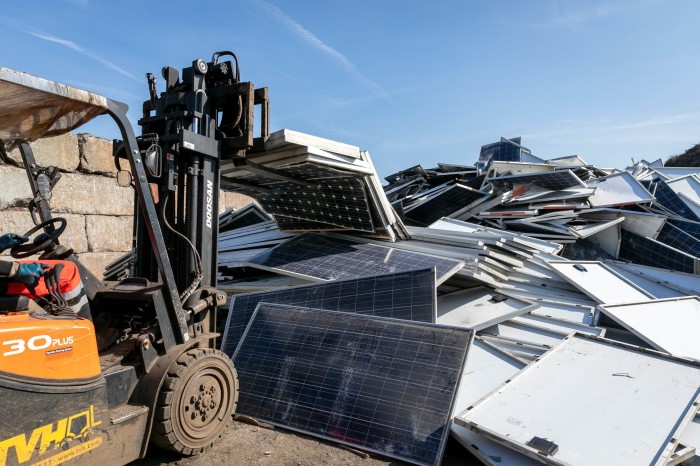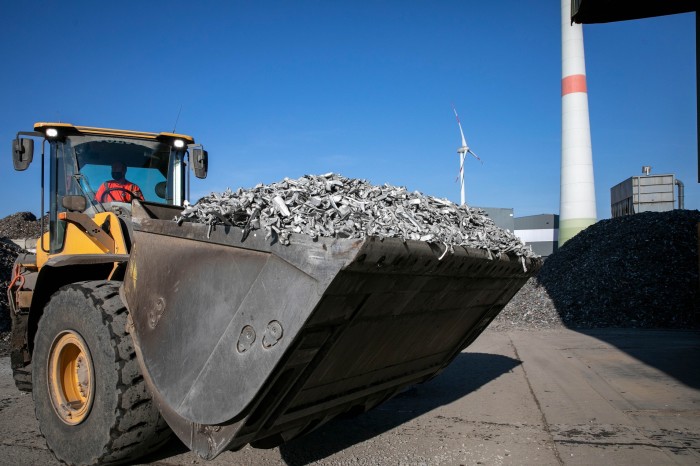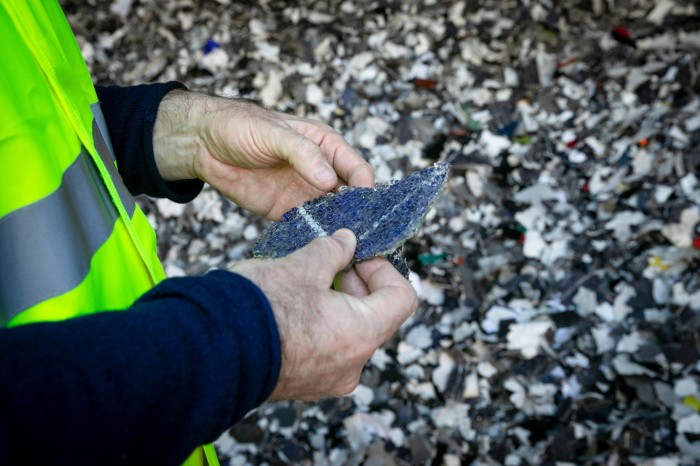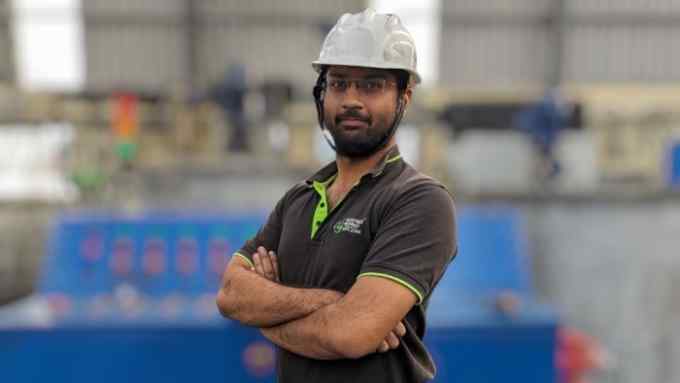Wind and solar power face an end-of-life sustainability challenge

Simply sign up to the Renewable energy myFT Digest -- delivered directly to your inbox.
Cars were a novelty once; so were oil wells, plastic bottles and coal-fired power stations. Novelty wears off, though — and, as the industries concerned acquired global heft, the environmental downsides became ever clearer.
But it is not only the giants of the fossil fuel era that must confront the loss of innocence that comes with scale. The huge increase in renewable energy in recent years — a doubling of capacity since 2013, with COP28 expected to produce a push for a tripling by 2030 — means that the solar and wind power sectors will soon face their own sustainability challenges.
“With average product lifetimes of about 30 years, the young solar industry has not yet faced waste streams that have necessitated the proactive integration of circular economy requirements,” points out Jan Clyncke, a board member at the Global Solar Council, a Washington DC-based industry organisation. That does not mean it will be caught napping, however. “Solar product and component manufacturers are taking the lead and looking at ways to increase the recyclability and end-of-life management of their products,” Clyncke adds.
The situation is similar for the wind industry. The lifespan of turbines also often reaches 25 or 30 years, says Alexander Vandenberghe, sustainability manager at WindEurope, a Brussels-based lobby group, which means there is relatively little end-of-life material today. But this will likewise change as wind turbine production rises massively to meet climate targets.
Preparing for the “huge wave” of solar panels that will need to be recycled in the future is a challenge, but one that industry should be ready to face, says Nicolas Defrenne, director-general of Soren, an organisation approved by the French government to collect used solar panels in France and its overseas territories. “We need to build capacity correctly,” says Defrenne. “[But] given regulation and market trends, there is no excuse not to be ready.”
For context, the production of a 1-terawatt peak photovoltaic system, the EU’s aim by 2030, will require 56mn tonnes of steel, 12.5mn tonnes of aluminium, 42mn tonnes of glass, 29,000 tonnes of silver, 2.3mn tonnes of silicon and 7mn tonnes of copper, Soren estimates.
To ensure that circularity is at the heart of this renewable energy transition will require well defined regulation. In the EU, solar panels are covered by the Waste Electrical and Electronic Equipment Directive, which stipulates that EU countries should collect 85 per cent of all electrical and electronic waste generated. However, Defrenne rues the fact that the law does not insist that recycling results in “good quality materials”.
A focus on quantity over quality, he says, also means that “the glass, which makes up the majority of a solar panel, is recycled, but there is less pressure to recycle low-volume, high-value materials like silver or silicon.”


In the wind industry, Vandenberghe says there are “well-established recycling practices for 85-95 per cent of a turbine” — weightier materials such as steel, iron, copper and aluminium. “[But] for the remaining 5-15 per cent, those practices have not been established at a scale that is large enough to be cost competitive.”
The permanent magnets used in modern turbines, and the rare earth minerals they contain, pose a particular technical challenge, he says — but several research projects are focused on solving the issue. “We are confident there will be a business case, as they are highly valuable”, he adds.
Defrenne wants “specific recovery targets” included in the next iteration of the WEEE directive for such minerals. “This is important for our economy, industrial sovereignty and the environment,” he says.
Indeed, environmental and human rights campaigners are concerned that the rush to expand renewable energy could bring about harms similar to those that have blighted fossil fuel operations over the decades. However, circularity policies can help reduce the need for extractive practices, reducing reliance on rare earth suppliers with poor records on the environment and human health.
“For a truly sustainable future, the green transition cannot come at the expense of the wellbeing of vulnerable communities,” says Marion Lupin, policy officer at the European Coalition for Corporate Justice, a non-profit.
She would like to see more explicit references to indigenous people’s rights in legislation, like the EU’s recently agreed Critical Raw Materials Act. “Abuses against indigenous peoples, common even within EU borders, as seen with the Sámi people, are set to remain unaddressed while policymakers prioritise geopolitical and financial interests,” says Lupin — referencing controversial plans for an iron ore mine on Sámi lands in Sweden.
Factoring the full life cycle of renewable energy facilities into tomorrow’s greener economies will not be easy. But Clyncke and Defrenne say there is a growing awareness globally of the need for action.
China, the world’s largest solar PV and wind energy market, has pledged to establish a “more or less mature full-process recycling system for wind turbines and solar panels by the end of this decade”, says Clyncke. Meanwhile, Defrenne highlights government policies on solar panel recycling in Australia, Japan and South Korea, and says that other nations, such as India and South Africa, “are starting to think about” how to develop the market.
For him, the key is securing the necessary investment to equip all countries with the right infrastructure, so that waste is not exported, and that recycled or recuperated materials can be used domestically.
Overall, Vandenberghe suggests it is mainly “administrative and legal barriers” that are preventing circular economy concepts from being scaled up. He cites EU waste classification rules that are ill-suited to products made from composite materials, such as turbine blades, and make it harder and costlier to export them for recycling.
Engineering knowhow is not the problem. “The technology is ready and will further improve once there is scale,” he says.

Comments